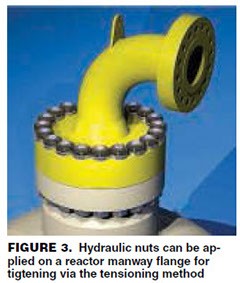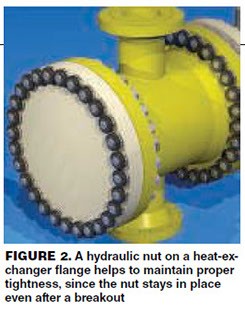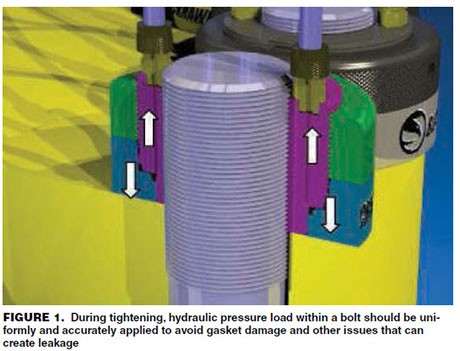BlackHawk™ Hydraulic Nuts vs. Torquing
The fundamental decision for flange assembly is whether to torque or tension. Hytorc Clamp Nut is a torquing process. Existing nuts are replaced with the clamp nut. The clamp nut is made up of an inner sleeve threaded to the bolt, an outer sleeve threaded to the inner sleeve and a thrust washer. The outer sleeve is torqued using a torque wrench reacting on the inner sleeve. The outer sleeve thrusts down against the washer to stretch the bolt and compress the gasket.
Torquing Issues
The torquing process used with the clamp nut is the same process to torque a standard nut. The hex nut of a standard assembly is replaced with a castellated, threaded sleeve. Torquing is a slow, tedious process that is difficult to control. Controlling the bolt load subjects operators to additional hand and back injuries.
The machined surfaces of the sleeve and the thrust washer can offer better control of friction under certain conditions. However, friction remains as an uncontrollable item due to additional variables involved: type of lubricant used, is the threaded portion of sleeve lubricated as well as the face of the sleeve, did the operator forget to lubricate the sleeve threads or the sleeve face?
Another variable that is very difficult to control with torquing is the effect of cross-talk when torquing bolts in a flange. The flange and gasket system are elastic/plastic springs in compression. As bolt load is applied, the flange and gasket compress in an unpredictable manner. When torque is applied to one bolt, the flange/gasket system compresses, releasing load in adjacent bolts that were just torqued. John Bickford refers to this as “cross-talk”. Cross-talk cannot be eliminated in a system unless all bolts are tightened simultaneously. Performing 100% torque tightening on a flange is possible, but it is complex and expensive.
Misalignment
Two other issues to control with torquing (clamp nut) are nut-stud-flange alignment and galling. Nuts and matching studs must be perfectly aligned 90° to the flange with clamp nut. If there is any misalignment, the outer sleeve will contact the washer at one point of the outer edge of the sleeve consistent with the direction of misalignment. As the sleeve continues to be torqued, the force generated with the sleeve face against the washer will bend the stud. The bending and point contact on the outer sleeve can significantly affect the torque to preload accuracy.
Galling
Galling between threaded surfaces can occur when the threads are turned under high load. The sleeve of the clamp nut is torqued under high forces with the matching threaded surfaces susceptible to galling.
Safety
During the tightening process using clamp nuts, there are many moves requiring lifting of the torque wrench and socket that subject the operator to repetitive lifting injury.
BlackHawk™ High Performance Nuts
The issues with speed, control and safety have been addressed with the 100% tensioning process of BlackHawk™ Nuts. One hundred percent tensioning provides fast, instant loading on all bolts, uniformly compressing the gasket.
BlackHawk™ Nuts require no additional heavy tools to tighten. Just click on a hydraulic hose and turn on a pump. This eliminates the back and hand injuries associated with manipulating a torque wrench.
BlackHawk™ Nuts apply a direct axial load. No threads are turned under load, so galling is eliminated.
BlackHawk™ Nuts are supplied with spherical washers to ensure effective use with no stud bending, in the event stud-flange misalignment exists.
Written by:
P. Gordon Britton, P. Eng.
President and CEO
INTEGRA Technologies
(C) INTEGRA Technologies Limited and INTEGRA Services Technologies, Inc. 2016. All Rights Reserved.
BlackHawk™ Hydraulic Nuts vs. Torquing Gallery
Get A Quote Today
One of our experts will be in touch within 24 hours to provide a free quote and advice.



